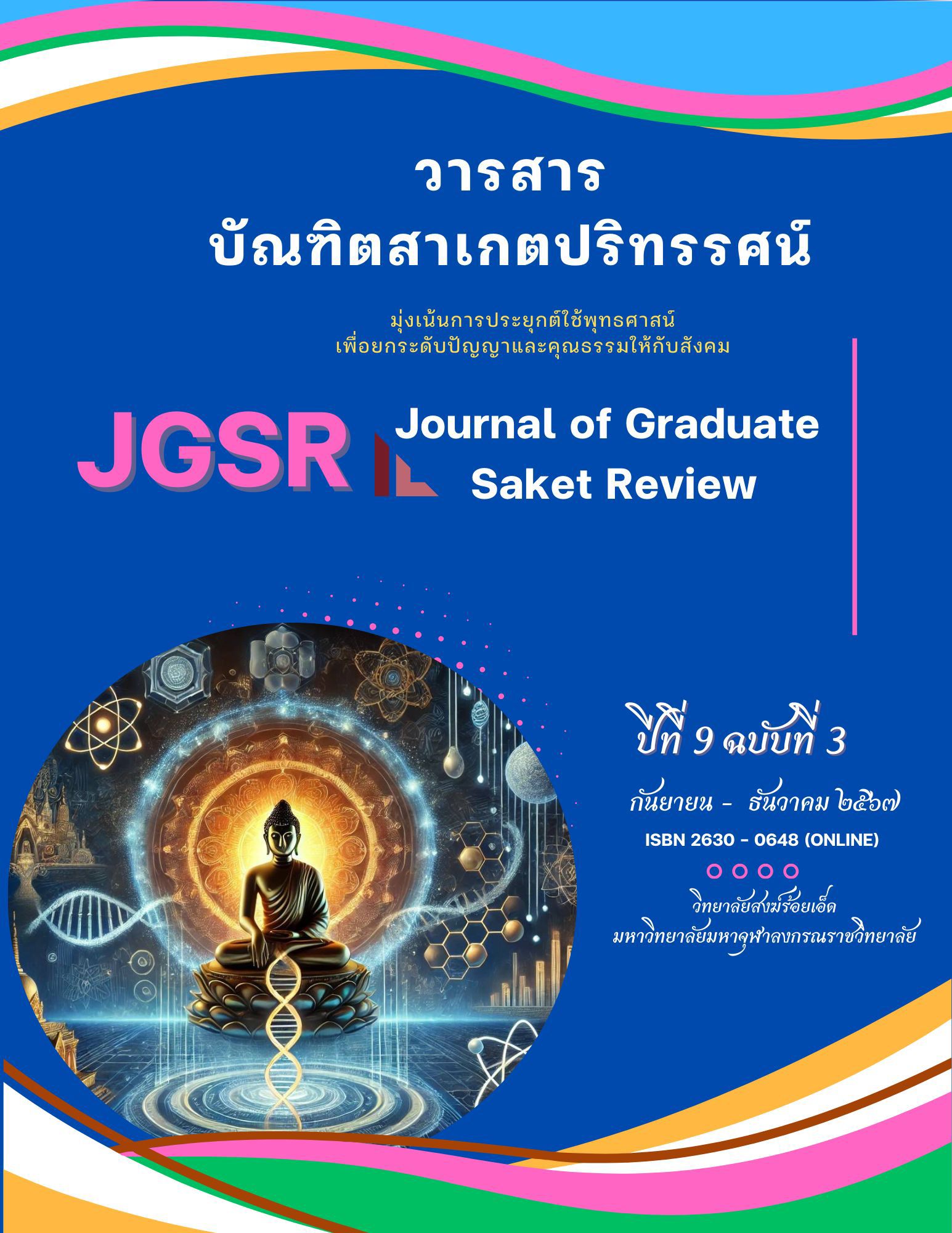การทำบุญออนไลน์ของพุทธศาสนิกชน
Main Article Content
บทคัดย่อ
บทความวิชาการนี้มีวัตถุประสงค์เพื่อศึกษาการทำบุญออนไลน์ของพุทธศาสนิกชน พบว่า บุญในความหมายที่เป็นทานคือการให้ อนุเคราะห์ สงเคราะห์ผู้อื่นด้วยความหวังดี ปรารถนาดี ทานมี 2 ประเภทสำคัญคือ อามิสทาน (การให้วัตถุสิ่งของ) และธรรมทาน (การให้ธรรมะ ความรู้) ลักษณะการให้ทาน เช่น ให้เพราะต้องการบุญ ให้เพราะต้องการชื่อเสียง คนยกย่องนับถือ เป็นต้น รูปแบบการให้ทานในอดีต เช่น ให้แก่คนที่มาเยือน เป็นต้น รูปแบบการให้ปัจจุบัน เช่น ถวายแก่พระสงฆ์ที่วัด ถวายแก่พระสงฆ์ที่นิมนต์มารับทานที่บ้านเจ้าภาพ ไถ่ชีวิตโค กระบือ เป็นต้น องค์ประกอบของทาน เช่น มีใจยินดีทั้งขณะก่อนให้ทาน ขณะให้ทาน และหลังให้ทานแล้ว เป็นต้น อานิสงส์ของทาน เช่น มีชื่อเสียงดีงาม มีโภคทรัพย์ ได้ไปสู่สุคติ เป็นต้น การทำบุญในปัจจุบันมีจุดมุ่งหมายหลายรูปแบบ เช่น ให้เพื่อสะเดาะเคราะห์ตามคำทำนายของหมอดู ให้เพื่อต้องการชื่อเสียง ให้เพราะต้องการได้ทิพยสมบัติ เป็นต้น การทำบุญออนไลน์เป็นที่นิยมทำกันในปัจจุบันเพราะมีความสะดวกสบาย เกณฑ์ตัดสินว่าการทำบุญออนไลน์นั้นจะได้บุญหรือได้มากน้อยเพียงใดนั้นขึ้นอยู่กับรูปแบบการทำบุญ เจตนาของผู้ทำบุญ กิริยาการทำบุญ ที่มาของวัตถุทาน และคุณสมบัติของผู้รับทาน
Article Details

อนุญาตภายใต้เงื่อนไข Creative Commons Attribution-NonCommercial-NoDerivatives 4.0 International License.
เนื้อหาและข้อมูลในบทความที่ลงตีพิมพ์ในวารสารบัณฑิตสาเกตปริทรรศน์ ถือเป็นข้อคิดเห็นและความรับผิดชอบของผู้เขียนบทความโดยตรงซึ่งกองบรรณาธิการวารสาร ไม่จำเป็นต้องเห็นด้วย หรือร่วมรับผิดชอบใด ๆบทความ ข้อมูล เนื้อหา รูปภาพ ฯลฯ ที่ได้รับการตีพิมพ์ในวารสารบัณฑิตสาเกตปริทรรศน์ ถือเป็นลิขสิทธิ์ของวารสารบัณฑิตสาเกตปริทรรศน์ หากบุคคลหรือหน่วยงานใดต้องการนำทั้งหมดหรือส่วนหนึ่งส่วนใดไปเผยแพร่ต่อหรือเพื่อกระทำการใด ๆ จะต้องได้รับอนุญาตเป็นลายลักอักษรจากวารสารบัณฑิตสาเกตปริทรรศน์ ก่อนเท่านั้น
เอกสารอ้างอิง
ภาษาไทย
พระครูโพธิชยธรรม. (2555). ศึกษาเปรียบเทียบการให้ทานสมัยพุทธกาลกับการให้ทานของชาวตำบลนาเลิง อำเภอเสลภูมิ จังหวัดร้อยเอ็ด. วิทยานิพนธ์พุทธศาสตรมหาบัณฑิต สาขาวิชาพระพุทธศาสนา. บัณฑิตวิทยาลัย: มหาวิทยาลัยมหาจุฬาลงกรณราชวิทยาลัย.
ประยุทธ์ หลงสมบุญ. (2546). พจนานุกรมมคธ-ไทย. พิมพ์ครั้งที่ 2. กรุงเทพมหานคร: บริษัทธรรมสาร จำกัด.
พระพรหมคุณาภรณ์ (ป.อ.ปยุตโต). (2551). พจนานุกรมพุทธศาสน์ ฉบับประมวลศัพท์. พิมพ์ครั้งที่ 11. กรุงเทพมหานคร: สํานักพิมพ์จันท์เพ็ญ.
พระธรรมสิงหบุราจารย์ (จรัญ ฐิตธมฺโม). (2548). ทาน ศีล ภาวนา นำพาพ้นกรรม. กรุงเทพมหานคร: โรงพิมพ์นันทพันธ์.
มหาจุฬาลงกรณราชวิทยาลัย. (2539). พระไตรปิฎกฉบับภาษาไทย ฉบับมหาจุฬาลงกรณราชวิทยาลัย. กรุงเทพมหานคร: โรงพิมพ์มหาจุฬาลงกรณราชวิทยาลัย.
________. พระไตรปิฎกภาษาบาลี ฉบับมหาจุฬาเตปิฏกํ. (2506). กรุงเทพมหานคร: โรงพิมพ์ รุ่งเรืองธรรม.
มหามกุฏราชวิทยาลัย. (2556). พระไตรปิฎกสยามรัฐ ภาษาบาลี. พิมพ์ครั้งที่ 7. กรุงเทพมหานคร: มหามกุฏราชวิทยาลัย.
________. (2556). พระไตรปิฎกและอรรถกถาแปล ฉบับมหามกุฏราชวิทยาลัย. พิมพ์ครั้งที่ 8. กรุงเทพมหานคร: มหามกุฏราชวิทยาลัย.
ราชบัณฑิตยสถาน. (2546). พจนานุกรมฉบับบราชบัณฑิตยสถาน. กรุงเทพมหานคร: นามมีบุ๊คส์ พับลิเคชั่นส์.
สมเด็จพระมหาสมณเจ้า กรมพระยาวชิรณาณวโรรส. (2538). สารานุกรมพระพุทธศาสนา. พิมพ์ครั้งที่ 2. กรุงเทพมหานคร: โรงพิมพ์มหามกุฎราชวิทยาลัย.
สมเด็จพระญาณสังวร สมเด็จพระสังฆราชสกลมหาสังฆปรินายก. (2548). วิธีสร้างบุญบารมี. กรุงเทพมหานคร: โรงพิมพ์นันทพัทธ์.
สมเด็จพระพุทธโฆษาจารย์. (2566). พจนานุกรมพุทธศาสน์ ฉบับประมวลศัพท์. พิมพ์ครั้งที่ 62. นครปฐม: วัดญาณเวศกวัน.
ภาษาอังกฤษ
Longsomboon P. (2003). Pali-Thai Dictionary. 2nd ed. Bangkok: Thammasarn Company Limited.
Mahachulalongkornrajavidyalaya University. (1996). Thai-language Tripitaka, Mahachulalongkornrajavidyalaya Edition. Bangkok: Mahachulalongkornrajavidya laya University Printing House.
________. (2506). Pali Tipitaka, Mahachula Tepitaka edition. Bangkok: Rungruangtham Printing House.
Mahamakut Buddhist University. (2556). Siamrath Tipitaka, Pali language. 7th edition. Bangkok: Mahamakut Buddhist University.
________. (2556). Tripitaka and commentary translation. Mahamakut Buddhist University edition. 8th edition. Bangkok: Mahamakut Buddhist University.
Phraphromkunaphon (P.A. Payutto). (2008). Buddhist Dictionary, Compiled Terminology Edition. 11th ed. Bangkok: Chanphen Publishing House.
Phrathammasinghaburacharn (Charan Thitthammo). (2005). Giving, Morality, Meditation Lead to Escape from Karma. Bangkok: Nantaphan Printing House.
Phrakhruphothichayatham. (2012). A comparative study of giving during the time of the Buddha and giving of the people of Na Leung Subdistrict, Selaphum District, Roi Et Province. Master of Buddhist Studies Thesis, Major in Buddhism. Graduate School: Mahachulalongkornrajavidyalaya University.
Royal Institute. (2546). Royal Institute Dictionary. Bangkok: Nammi Books Publications.
Somdejphramahasamanachao Kromphrayavajirananavaroros. (1995). Encyclopedia of Buddhism. 2nd ed., Bangkok: Mahamakut Rajavidyalaya Printing House.
Somdejphrayanasangwon, Somdejphrasangharaja Sakonmahasanghaparinayok. (2005). Methods of creating merit. Bangkok: Nantaphat Printing House.
Somdejphrabuddhakosajarn. (2023). Dictionary of Buddhism, Compiled Edition. 62nd ed. Nakhon Pathom: Wat Yanwaesakwan.


